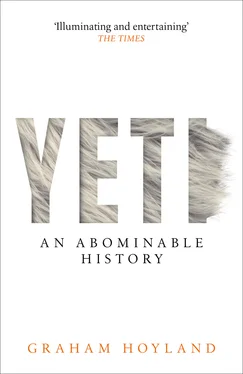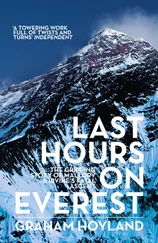While contouring round the foot of the ridge between these two feeder glaciers, we saw in the snow the tracks of an Abominable Snowman. They were eight inches in diameter, eighteen inches apart, almost circular, without signs of toe or heel. They were three of four days old, so melting must have altered the outline. The most remarkable thing was that they were in a straight line one behind the other, with no ‘stagger’ right or left, like a bird’s spoor. A four-footed animal walking slowly puts its hindfoot in the track of its forefoot, but there are always some marks of overlapping, nor are the tracks immediately in front of each other. However many-legged it was, the bird or beast was heavy, the tracks being nearly a foot deep. We followed them for a mile, when they disappeared on some rock. The tracks came from a glacier pool where the animal had evidently drunk, and the next day we picked up the same spoor on the north side of Snow Lake.
The Sherpas judged them to belong to the smaller type of Snowman, or yeti, as they call them, of which there are apparently two varieties: the smaller, whose spoor we were following, which feeds on men, while his larger brother confines himself to a diet of yaks. My remark that no-one had been here for thirty years and that he must be devilish hungry did not amuse the Sherpas as much as expected! The jest was considered ill-timed, as it perhaps was, the three of us standing forlorn and alone in a great expanse of snow, looking at the strange tracks like so many Robinson Crusoes. 13
Tilman attempted to take a photograph but claimed that he managed to make two exposures on the same negative and so nothing came out. This seems odd, as he seemed perfectly competent with his camera on other expeditions. One might begin to smell a horrible, hairy rat. Later, his team saw bear tracks and agreed that they were completely unlike what they had seen earlier. The first set of prints he reported as circular, with no toes. Tilman speculates on the nature of the creature: ‘A one-legged, carnivorous bird, weighing perhaps a ton, might make similar tracks, but it seems unnecessary to search for a new species when we have a perfectly satisfactory one at hand in the form of the Abominable Snowman – new perhaps to science but old in legend.’
They followed the footprints for a mile. His diary notes tersely: ‘Sixteen inches apart and about 6–8 inches in diameter. Blokes say it is hairy like a monkey.’
On The Times letters page, Shipton chipped in with his own sighting. ‘With two Sherpas I was crossing the Bireh Ganga glacier when we came upon tracks made in crisp snow which resembled nothing so much as those of an elephant. I have followed elephant spoor often and could have sworn we were following one then but for the comparative scarcity of these beasts in the Central Himalaya.’
If you are attuned to the Shipton–Tilman dynamic, you might begin to hear the gentle sound of the piss being taken. Then – and here’s a point relevant to Ernst Schäfer’s accusation – Tilman chimed into suggest a search expedition: ‘I notice regretfully that the correspondence appears to be failing and that a zoologist (Huxley) has been afforded space to drive yet another nail into the coffin of our abominable friend having first poisoned him with another dose of Latin. Difficult though it is, the confounding of scientific sceptics is always desirable, and I commend the suggestion that a scientific expedition should be sent out. To further this an Abominable Snowman Committee, on the lines of the Mount Everest Committee, might be formed, drawn from the Alpine Club and the Natural History Museum.’
Were Tilman and Shipton hinting that more public money might be raised to pay for their expeditions, this time to pursue the Abominable Snowman?

Despite including seven strong climbers, Tilman’s 1938 Everest expedition got no higher than the Norton and Somervell high point of 28,000 feet. Food became a point of contention among the team members; in the name of austerity Tilman had refused the gift of a crate of champagne from a well-wisher, and listed porridge and soup as luxuries. Noel Odell, in particular, objected to the ration of two pounds per day of flour and lentils after enjoying quails in aspic and chocolates on the 1924 Everest expedition. He blamed the parsimonious diet for the recurrent illness and weakness of the party. Bill Tilman gave a typically sarcastic response to this in Appendix A of his expedition book: ‘I must confess I was surprised to hear any criticism of the food, except from Odell, who has not yet finished criticising the food we ate on Nanda Devi in 1936 and who, in spite of his half-starved condition, succeeded in getting to the top.’ 14
However, Odell did have a point: once again, the British had failed on Everest. Little did they know that their youngest Sherpa, 24-year-old Tenzing Norgay, would finally manage to climb the mountain in 1953 with Edmund Hillary. He was described by the leader as young, keen, strong and very likeable. Shipton had employed him on the 1935 Everest reconnaissance expedition, catching his flashing smile in the employment lines. Nor could they suspect that a British woman, Rebecca Stephens, would climb Everest in 1993; a 13-year-old boy, Jordan Romero, would climb it in 2010; or an 80-year-old Japanese man, Yuichiro Miura, in 2013. Surely, they wouldn’t believe that 234 people would reach the top in a single day in 2012. One of the greatest mysteries about mountains is how they appear to lose their difficulty. As British mountaineer and author Albert Mummery said: ‘It has frequently been noticed that all mountains appear doomed to pass through the three stages: An inaccessible peak – The most difficult ascent in the Alps – An easy day for a lady.’ 15This is not a topic for this book, but it has been addressed at length in at least one other. 16
Once again, the weather was bad that year so they retreated to the Rongbuk monastery, where they had already noticed that someone had demolished the monument to those who died in 1924 (the carved stone panels on this had been executed by Howard Somervell, the polymath, in an Arts and Crafts style). Tilman and the other climbers questioned the lamas:
Odell, who as a member of the 1924 expedition was particularly interested, then asked who had destroyed the big cairn erected at the Base Camp … The abbot disclaimed all responsibility on the part of the monastery and suggested that the culprits were the ‘ Abominable Snowmen ’. This reply staggered me, for though I had an open mind on the matter I was not prepared to hear it treated so lightly in that of all places. I was shocked to think that this apparently jesting reply, accompanied as it was by a chuckle from the abbot and a loud laugh from the assembled monks, indicated a disbelief in the ‘Abominable Snowman’ … Further questioning showed clearly that no jest was intended, and we were told that at least five of these strange creatures lived up near the snout of the glacier and were often heard at night. 17
Another explanation could be that the monument, which might have been considered to sacrilegiously resemble a Tibetan religious chorten, had indeed been demolished by the lamas. 18
There was more to see in the Rongbuk monastery. In the innermost shrine, they were shown a piece of rock with ‘the very clear impress of a large human foot’. Odell, a geologist of some standing, could not provide an explanation. Another mysterious footprint!

Tilman’s book of the expedition, Mount Everest 1938 , was not published until ten years later, after the war. In it he discusses the Abominable Snowman at length: ‘Since no book on Mount Everest is complete without appendices, I have collected all the available evidence, old and new, and relegated it to the decent obscurity of Appendix B.’ As well as being obscure, Appendix B 19is now extremely hard to find (having been unaccountably left out of the otherwise excellent Diadem edition of his collected Mountain-Travel books). It is written in a suspiciously jocular manner – ‘Nothing like a little judicious levity’ – but Tilman manages to make the case for the Abominable Snowman whilst undermining him and at the same time hinting that he doesn’t take the whole phenomenon entirely seriously. In fact, this is a masterpiece of sustained comic irony, a difficult rhetorical trick to pull off but one that Tilman manages, time and time again.
Читать дальше












